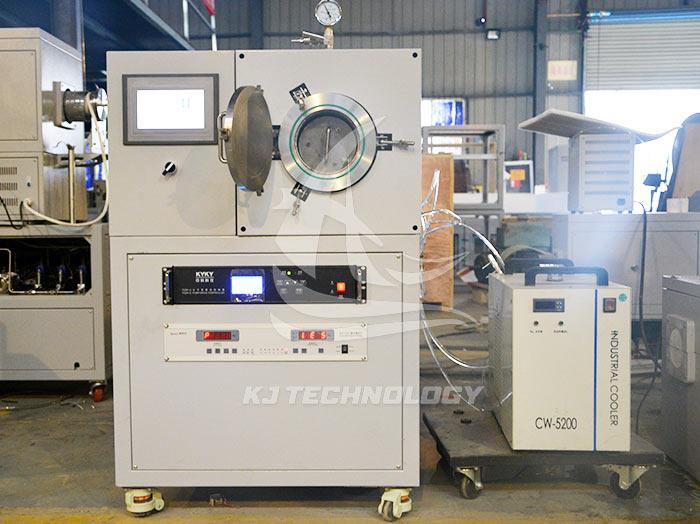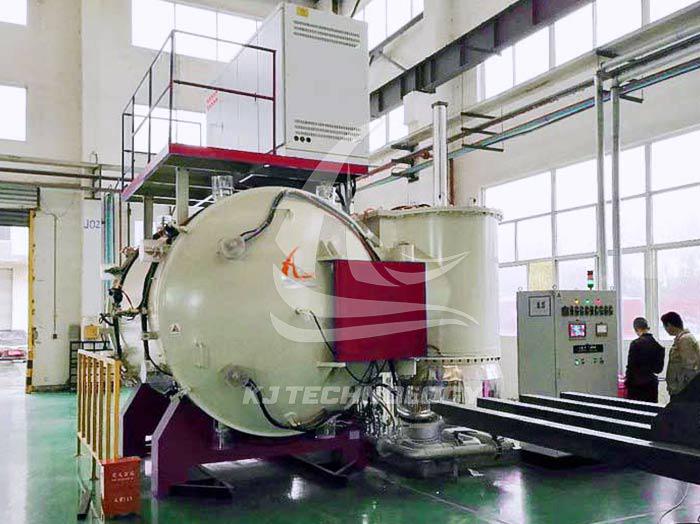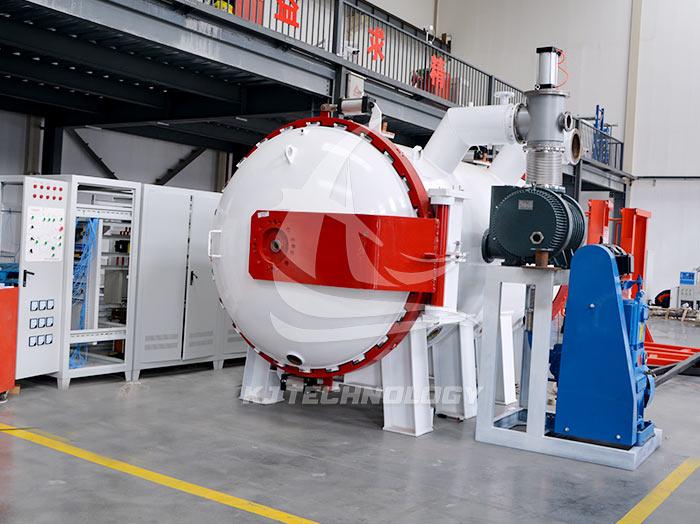Pressure sintering furnace
 07-09-2025 Author: KJ technology
07-09-2025 Author: KJ technology
Pressure sintering furnace is a key equipment for achieving material densification in high temperature and high pressure environments, widely used in the sintering process of high-performance materials such as ceramics, metal composites, and hard alloys. The following is an introduction from five dimensions: core parameters, working principle, equipment type, application field, and operation points:
1. Core parameters: precise control of high temperature and high pressure
The core performance of a pressure sintering furnace is reflected in its ability to synergistically control temperature and pressure
Temperature range: up to 2000 ℃, commonly used working temperature is 1900 ℃, temperature control accuracy is ± 2 ℃, temperature uniformity is ≤± 5 ℃ (vacuum state) or ± 7 ℃ (pressurized state). For example, the structure of graphite heating element and isostatic pressed graphite insulation layer can ensure a temperature fluctuation of ≤± 2 ℃ at 1550 ℃.
Pressure range: The upper limit of the design pressure is 10MPa, the normal working pressure is ≤ 9.5MPa, and the pressure fluctuation is controlled within ± 0.02MPa during the holding period. The high-pressure inflation adopts a slope type pressurization method to ensure a smooth increase in pressure.
Chamber design: The effective loading size of the vertical structure can reach φ 300mm × H500mm, meeting the sintering requirements of large-sized workpieces.
2. Working principle: densification mechanism of temperature pressure synergy
The pressure sintering furnace achieves high-temperature and high-pressure sintering through a vacuum or inert gas environment, and its typical process includes:
Vacuum pumping stage: three-stage vacuum pumping with mechanical pump, Roots pump, and diffusion pump, with a maximum vacuum degree of ≤ 2Pa, effectively eliminating air inside the furnace and preventing material oxidation.
Heating stage: The graphite heating element is electrically heated, with a heating rate of up to 20 ℃/min, and supports multi-stage heating programs (such as segmented insulation to eliminate thermal stress).
Pressure stage: Apply pressure through a hydraulic system, and the synergistic effect of pressure and temperature promotes material densification. For example, in the sintering of hard alloys, pressure can eliminate porosity and improve the strength and hardness of the product.
Insulation and pressure stage: Maintain the target temperature and pressure for a certain period of time to ensure that the material fully reacts and crystallizes.
Cooling stage: Water jacket cooling or natural cooling is used, and some equipment supports rapid cooling technology from 1600 ℃ to 100 ℃ within 30 minutes to shorten the process cycle.
3.Equipment type: Suitable for different process requirements
According to their structure and application scenarios, pressure sintering furnaces can be divided into the following types:
Vacuum pressure atmosphere sintering furnace: suitable for the field of powder metallurgy, with a vacuum working temperature of 1600 ℃ and a pressurized working temperature of 1550 ℃, a rated pressure of 6.0MPa, and a leakage rate of 5Pa/h.
High temperature vertical atmosphere pressure sintering furnace: rated temperature of 2000 ℃, rated pressure of 10MPa, chamber capacity of φ 300mm × H500mm, supporting medium pressure sintering of high-performance materials such as ceramics and metal composite materials.
Bell type pressurized sintering furnace: dedicated to the production of powder metallurgy friction plates, forming a closed space through sand sealing, and using decomposed ammonia gas as a protective atmosphere.
Microwave sintering oven: using microwave heating to achieve rapid sintering, can reduce sintering temperature by 500 ℃, save energy by 70% -90%, shorten time by more than 50%, suitable for materials such as ceramics and hard alloys.
4. Application area: Key preparation tools for high-performance materials
The pressure sintering furnace plays an irreplaceable role in the following fields:
Ceramic materials: densification sintering of structural ceramics (such as alumina and silicon nitride) and functional ceramics (such as piezoelectric ceramics and magnetic ceramics).
Metal composite materials: diffusion bonding and sintering forming of metal based composite materials (such as aluminum based and titanium based composite materials).
Hard alloy: By gas pressure sintering, porosity is eliminated, and the strength and hardness of cutting tools, molds, and other products are improved.
Special powder metallurgy: sintering of special parts such as high-speed steel, stainless steel, friction plates, etc., supporting vacuum or high-pressure inert atmosphere environment.
5. Key points of operation: Balance between safety and efficiency
Atmosphere control:
Before using hydrogen or decomposing ammonia, nitrogen should be introduced to exhaust the air to prevent explosion.
Molybdenum wire heating elements need to be filled with protective gas before being powered on to avoid oxidation and brittle fracture.
Open flames should be installed on the furnace door and gas exhaust outlet to prevent danger caused by oxygen entering or hydrogen being discharged.
Temperature management:
The iron chromium aluminum resistance wire heating element should stay for 30 minutes when heated to 1100 ℃ to prevent damage due to excessive surface temperature.
Before heating up, it is necessary to check whether the airflow and water flow meet the requirements to ensure the normal operation of the equipment.
Shutdown specifications:
Before shutting down the furnace, the power should be cut off first, and the gas and water should be stopped only when the furnace temperature drops below 200 ℃.
Avoid frequent shutdowns to reduce the risk of heating element aging and refractory material fragmentation.
Fixtures and Boats:
Choose a suitable firing boat (such as a graphite boat or ceramic board) based on the shape of the workpiece to avoid deformation and prevent boat jamming accidents.
Special workpieces require the design of specialized fixtures to ensure stable positioning during the sintering process.








